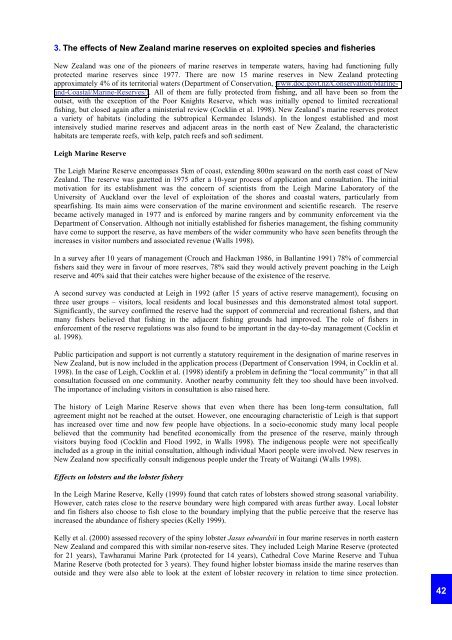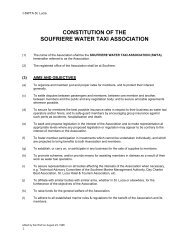WWF Cover photo - Soufriere Marine Management Association ...
WWF Cover photo - Soufriere Marine Management Association ...
WWF Cover photo - Soufriere Marine Management Association ...
Create successful ePaper yourself
Turn your PDF publications into a flip-book with our unique Google optimized e-Paper software.
3. The effects of New Zealand marine reserves on exploited species and fisheriesNew Zealand was one of the pioneers of marine reserves in temperate waters, having had functioning fullyprotected marine reserves since 1977. There are now 15 marine reserves in New Zealand protectingapproximately 4% of its territorial waters (Department of Conservation, www.doc.govt.nz/Conservation/<strong>Marine</strong>and-Coastal/<strong>Marine</strong>-Reserves/).All of them are fully protected from fishing, and all have been so from theoutset, with the exception of the Poor Knights Reserve, which was initially opened to limited recreationalfishing, but closed again after a ministerial review (Cocklin et al. 1998). New Zealand’s marine reserves protecta variety of habitats (including the subtropical Kermandec Islands). In the longest established and mostintensively studied marine reserves and adjacent areas in the north east of New Zealand, the characteristichabitats are temperate reefs, with kelp, patch reefs and soft sediment.Leigh <strong>Marine</strong> ReserveThe Leigh <strong>Marine</strong> Reserve encompasses 5km of coast, extending 800m seaward on the north east coast of NewZealand. The reserve was gazetted in 1975 after a 10-year process of application and consultation. The initialmotivation for its establishment was the concern of scientists from the Leigh <strong>Marine</strong> Laboratory of theUniversity of Auckland over the level of exploitation of the shores and coastal waters, particularly fromspearfishing. Its main aims were conservation of the marine environment and scientific research. The reservebecame actively managed in 1977 and is enforced by marine rangers and by community enforcement via theDepartment of Conservation. Although not initially established for fisheries management, the fishing communityhave come to support the reserve, as have members of the wider community who have seen benefits through theincreases in visitor numbers and associated revenue (Walls 1998).In a survey after 10 years of management (Crouch and Hackman 1986, in Ballantine 1991) 78% of commercialfishers said they were in favour of more reserves, 78% said they would actively prevent poaching in the Leighreserve and 40% said that their catches were higher because of the existence of the reserve.A second survey was conducted at Leigh in 1992 (after 15 years of active reserve management), focusing onthree user groups – visitors, local residents and local businesses and this demonstrated almost total support.Significantly, the survey confirmed the reserve had the support of commercial and recreational fishers, and thatmany fishers believed that fishing in the adjacent fishing grounds had improved. The role of fishers inenforcement of the reserve regulations was also found to be important in the day-to-day management (Cocklin etal. 1998).Public participation and support is not currently a statutory requirement in the designation of marine reserves inNew Zealand, but is now included in the application process (Department of Conservation 1994, in Cocklin et al.1998). In the case of Leigh, Cocklin et al. (1998) identify a problem in defining the “local community” in that allconsultation focussed on one community. Another nearby community felt they too should have been involved.The importance of including visitors in consultation is also raised here.The history of Leigh <strong>Marine</strong> Reserve shows that even when there has been long-term consultation, fullagreement might not be reached at the outset. However, one encouraging characteristic of Leigh is that supporthas increased over time and now few people have objections. In a socio-economic study many local peoplebelieved that the community had benefited economically from the presence of the reserve, mainly throughvisitors buying food (Cocklin and Flood 1992, in Walls 1998). The indigenous people were not specificallyincluded as a group in the initial consultation, although individual Maori people were involved. New reserves inNew Zealand now specifically consult indigenous people under the Treaty of Waitangi (Walls 1998).Effects on lobsters and the lobster fisheryIn the Leigh <strong>Marine</strong> Reserve, Kelly (1999) found that catch rates of lobsters showed strong seasonal variability.However, catch rates close to the reserve boundary were high compared with areas further away. Local lobsterand fin fishers also choose to fish close to the boundary implying that the public perceive that the reserve hasincreased the abundance of fishery species (Kelly 1999).Kelly et al. (2000) assessed recovery of the spiny lobster Jasus edwardsii in four marine reserves in north easternNew Zealand and compared this with similar non-reserve sites. They included Leigh <strong>Marine</strong> Reserve (protectedfor 21 years), Tawharanui <strong>Marine</strong> Park (protected for 14 years), Cathedral Cove <strong>Marine</strong> Reserve and Tuhua<strong>Marine</strong> Reserve (both protected for 3 years). They found higher lobster biomass inside the marine reserves thanoutside and they were also able to look at the extent of lobster recovery in relation to time since protection.42



